OALP XIX Seminar 6 (Part 2: Washington, D.C.)
Tuesday, March 5, 2019
We finally made it to D.C.! First stop was USDA, where Kathrine Hill showed us to our meeting room. To pass a little time, Kathrine shared a bit of her history/”her story.” Next, we learned about the history of NRCS, EQUIP, CRP, etc. from Kevin Wickey and Kevin Norton. Kevin is from southwestern Oklahoma and helped formulate language in the upcoming Farm Bill.
The class then learned about federal crop insurance and RMA. We first spoke with Martin Barbre who was appointed by Secretary Sonny Purdue over the federal crop insurance program. Mr. Barbre expressed the importance of getting rural America to Washington, D.C., sharing our stories and fighting for fellow farmers/ranchers. Dave Miller then updated us on RMA. Dave has been with RMA for 25 years and is very proud of the public/private relationship with the federal crop insurance program. Private insurance alone cannot stand the risk and it is important that the government is involved to help protect our food source. Lastly, we heard from Laura Griffin about SNAP. SNAP is a federal program administered through the states to help low-income families recieve necessary nutrition.
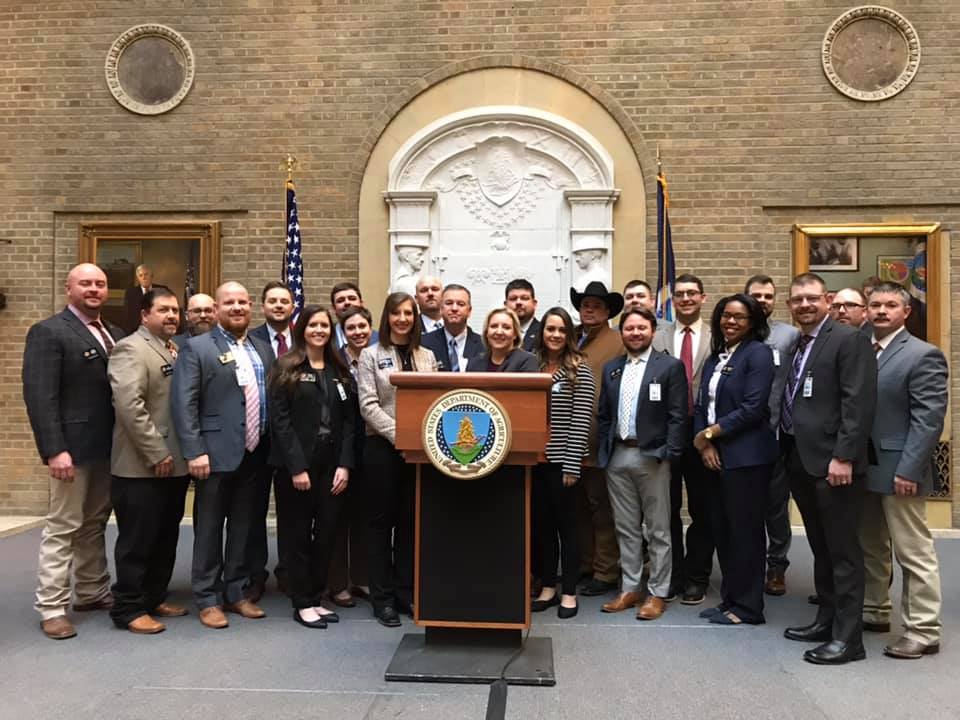
After USDA, we headed to the National Cattlemen’s Beef Association. We heard from Colin Woodall about issues the Association is currently working on. Mr. Woodall expressed the need to build strong relationships with our elected officials and their assistants. He also stressed using land-grant universities to get unbiased, third-party facts and figures as research is conducted. Next, Allison Rivera spoke about transportation issues that NCBA is working on to help with the timely transport of livestock in regards to electronic logs and hours of service and Scott Yager provided insight about Waters of the U.S. (WOTUS). We then heard from Darryl Blakey, who works on marketing issues for NCBA, about how the Association helps look at cattle contracts with Commodity Futures Trading Commission.
We ended our time at NCBA by listening to Kent Bacus, who works on international trade issues for the Association. Currently, Japan is a desirable market but we are suffering a 38% tariff on goods sent there. We left NCBA and headed to the Humane Society of the United States.
Via Skype/phone conference meeting, we visited with Scott Beckstead, Keith Dane and Cynthia Armstrong from HSUS. We learned more about HSUS and its mission. The group learned HSUS rejects the industrial model of raising livestock, wants to assist law enforcement in animal cruelty cases and is against concentrated animal feeding operations (CAFOs). It was an interesting conversation and positive debate with HSUS representatives.
Wednesday, March 6, 2019
We began the day at U.S. Wheat Associates headquarters in Arlington, Va. Amanda Spoo shared their organization was developed to help with wheat export markets. U.S. Wheat Associates is funded by checkoff dollars. One-third of a penny from checkoff comes to the organization. They have 15 offices: two domestic and 13 internationally. All of their activities provide trade servicing that educates buyers. They also provide technical assistance for millers and processors and conduct short courses. They have a wheat quality improvement team and conduct consumer promotion and education. Ben Conner, vice president of policy, shared that trade policy covers all things involved in overseas market development through government policy. The priorities are the U.S. Mexico Canada Agreement and U.S. – Japan Trade Agreement. Trade wars are difficult on the China/Japan tariffs. Brazil has a tariff-free quota for 30 million bushels of hard red winter wheat.
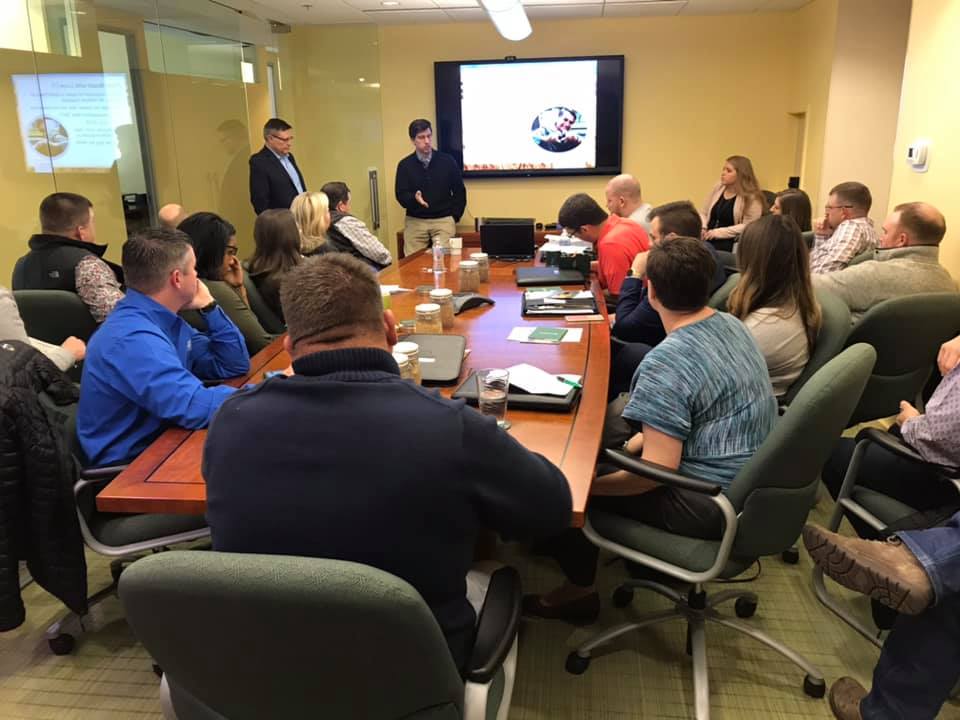
We then traveled to In-Q-Tel to learn about agroterrorism and technology in agriculture. Dr. Stephanie Rogers, vice president and deputy director of B.Next, told us bioweapons are a strategic threat. Technology is transforming agriculture. Biology can be a threat against us as much as it can be to our advantage. Biothreats are a national security concern. Agriculture is vulnerable to agroterrorism because crops are grown over large areas, the concentrated nature of the industry, difficulty of surveillance, complexity of hosts and pathogens, international movement, and high impact on economic, social and political areas.
Tara O’Toole, executive vice president of In-Q-Tel, then shared her insight. Tara has had a split career between academic and government work. The Plum Island Animal Disease Center was something in which she was involved. She later helped develop a BSL4 level facility called the National Bio and Agro-defense Facility (NBAF) located in Manhattan, Kan. This facility will conduct foot and mouth disease (FMD) research and any other projects requiring high containment. Funding will fall into the DHS budget for protection of our country’s agricultural assets. Federal spending in research and development is continually declining which is contrary to the needs of this country to protect our agricultural industry. The risk of not building NBAF far outweighed the risk of not building for the interest of protecting our country. Some of the greatest worries about NBAF is not the technology, but the upkeep of that very sophisticated technology. We have to maintain the culture and budget for safety at a facility like this.
Thursday, March 7, 2019
Today’s focus was Capitol Hill. Our first sit down at the U.S. Capitol was with Dan Hillenbrand, the policy advisor for Senator Jim Inhofe. Dan talked about how Oklahoma has a delegation that communicates very well and helps each other make decisions that have the best impact in Oklahoma. The Farm Bill also was a hot topic of discussion. Dan mentioned that SNAP needed to be a part of the Farm Bill to receive bipartisan support of it, otherwise he felt some would not see its importance. Dan’s advice for the group was to be involved in state-level associations to be heard. Next, Congressman Markwayne Mullin talked to us about the Green New Deal and the fact that most people look at it as far-fetching and unrealistic, but from a longterm perspective, it is something that Oklahomans should be concerned with because our two top streams of income are agriculture and energy.
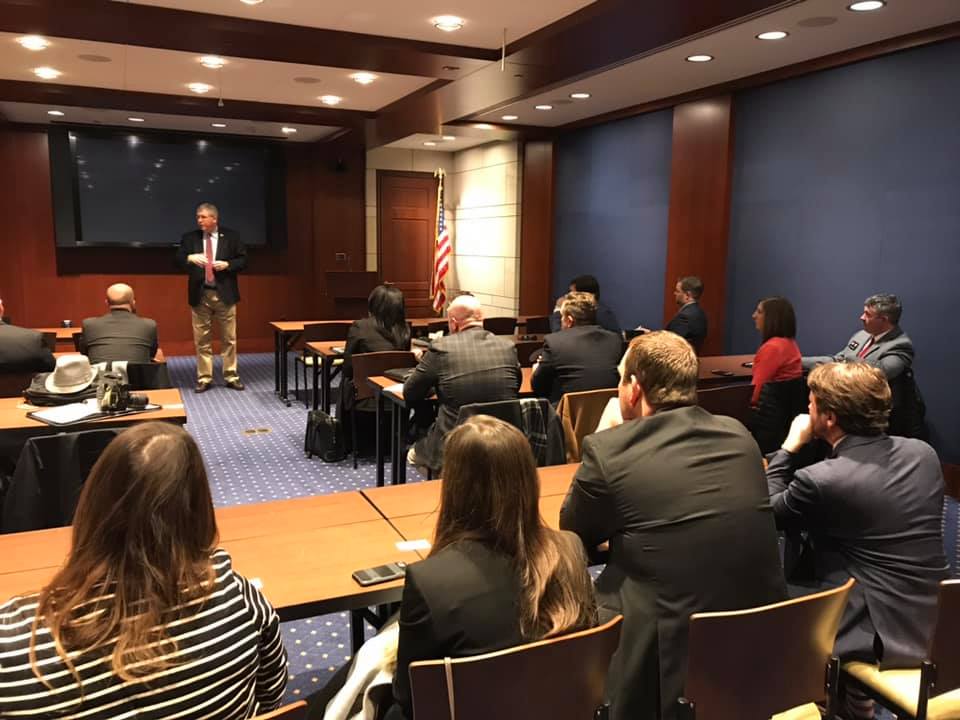
Congressman Frank Lucas then shared his knowledge of agricultural policy. He outlined some of the trade talks that are going on and the opportunity for the U.S. to be an even bigger player in the global economy with agriculture moving forward. Next, Senator James Lankford took time to talk with us. He mentioned the need to have SNAP as part of the Farm Bill but from a slightly different standpoint of linking rural and urban together. One main thing Lankford discussed was the need for us as a country to become more financially responsible and that some individuals in Washington, D.C., do not see our debt level as an issue. Senator Langford also spoke of the trade deals impacting agriculture and that more specifically the Section 301 tariffs on China could have a larger impact going forward. Our next speaker was Joshua Jackson, legislative assistant for Congressman Tom Cole. He gave the group a glimpse into how things get operate in Washington, D.C., and how communication from constituents does impact legislative assistants’ recommendations to senators and congressmen. After meeting with the legislators, we toured the Capitol and sat in on some discussion in the galleries of the U.S. House and Senate Chambers. This experience was interesting. The bills that were being discussed were not of particular interest to the group, but the manner in which they were taking place was quite interesting.
Later that evening, we gathered for a night tour of the monuments in D.C.
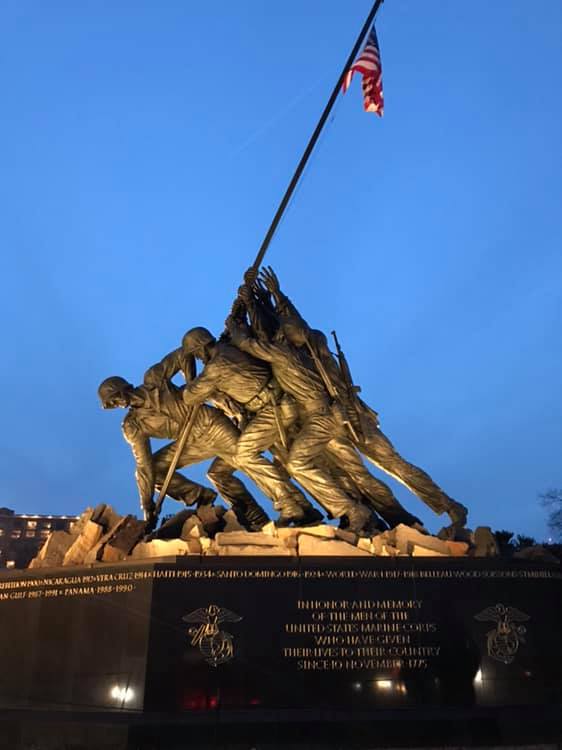
Friday, March 8, 2019
We started the day by departing for Mount Vernon, Va. Our first stop was at the Gristmill and Distillery. Steve Bashore shared the history of the mill and how it was first started by George Washington’s grandfather. Steve demonstrated to us how the mill operated. The mill is powered by a waterwheel. They can produce either cornmeal or flour. We also visited the Distillery where they make some of the finest whiskey in the area
We then went to the Pioneer Farm to see how George Washington and his family lived more than 200 years ago. George Washington is most widely known as the first President of the U.S., but he wanted to be remembered as a visionary farmer. Washington did a lot of experimental test plots determining which crops, soils and manure treatments produced the best yields. After touring the Pioneer Farm, we went through Washington’s Mansion. When the tour was over, we departed to our next stop: the Surratt House Museum.
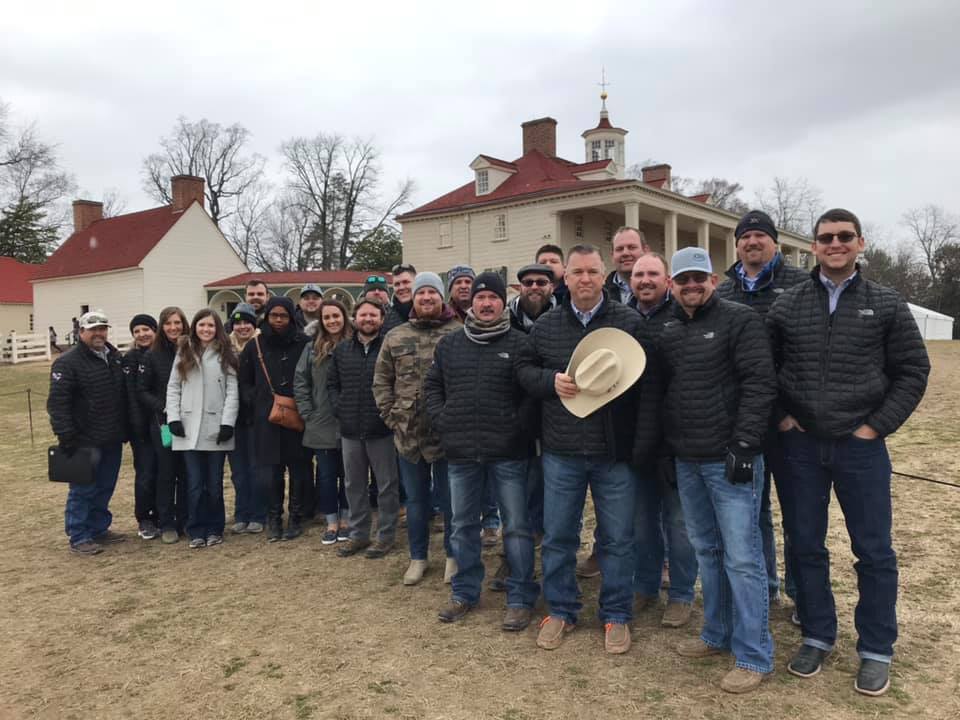
We arrived at the Surratt House Museum which is believed to be where John Wilkes Booth hid out after assassinating President Abraham Lincoln. We learned that Mr. Surratt had built a successful local pub, but he eventually drank himself to death leaving Mrs. Surratt and her daughter with quite a mess to rebuild. Their son, who was in the military, was believed to be good buddies with Booth. When the plan to kidnap Lincoln went south, Booth decided to shoot and kill the President. When he was fleeing from the scene he injured his leg. During Booth’s flight out of Washington, D.C., the assassin stopped at the Surratt Tavern to retrieve weapons and supplies which had been hidden there. Eventually law enforcement caught up with him and six people were convicted of being in on the murder. Three people were executed including Mrs. Surratt. She is the only woman to ever be executed by the state of Maryland.
Our last stop of the day was Miller Farms. Miller Farms is a true field-to-plate produce grocery store. The Miller family has grown and sold produce where they live for the last five generations. They have several greenhouses along with a bakery. Today, they have several entities which include products and produce from their own farm. The Millers were very gracious hosts and fed us an amazing dinner. They went above and beyond for us.
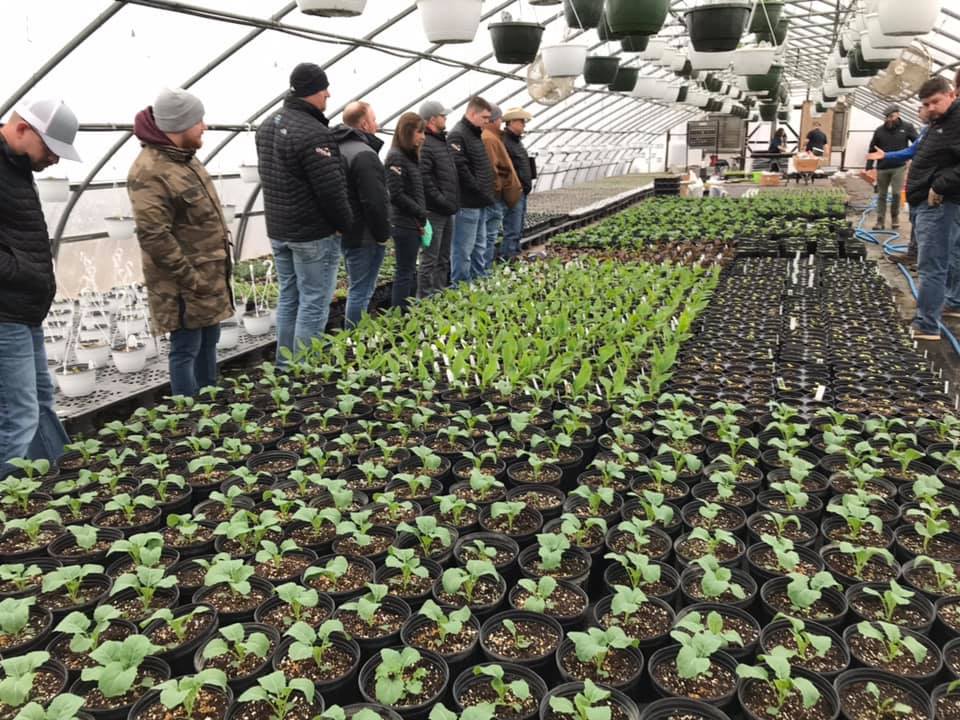
Saturday, March 9, 2019
After breakfast, we loaded up the bus and traveled to Arlington National Cemetery. After getting our tickets, we headed over to watch the changing of the guard, followed by walking around to view the other areas and memorials, one area being the eternal flame and JFK memorial. Around noon, the group loaded onto the bus and headed to the airport. After getting everyone checked in, we went through security and found a place to eat. Our plane left at 3:00 p.m. and we arrived in Oklahoma City around 5:15 p.m. We grabbed our luggage and headed home. We had a great week in Washington, D.C., and look forward to seminar 7 in Oklahoma City!
Sincerely,
Kristin Young, Class XIX
OALP XIX Seminar 6 (Part 1: Pennsylvania)
Saturday, March 2, 2019
Seminar 6 began at Will Rogers Airport in Oklahoma City. We were all excited to be reunited. We quickly made our way through check-in and the security process. We had a little over an hour before we departed so we enjoyed conversation and catching up on the last month’s activities. One we landed in D.C., we loaded the bus and headed off to our first destination: Gettysburg, Penn. The bus ride was fairly quiet due to the three-hour flight. It would all change on our arrival to one of the coolest towns in America.
When we arrived, we enjoyed dinner at the oldest building in town, the Dobbin House Tavern. The food was great and we had a short history lesson on the tavern and the town. Our group enjoyed touring the building and assuring each other we saw one of their legendary ghosts. The group worked off dinner by having an ultimate snow ball fight through the streets of Gettysburg. It was epic to say the least. Our group leader, Edmond Bonjour, somehow convinced the group to follow him into a closed cemetery at night, which was a wonderful idea. In hindsight it was really cool, a little scary and definitely worth it in the end. Our first day was an absolute success. It was a great introduction into what was in store for the rest of our journey.
Sunday, March 3, 2019
We began the day at Gettysburg Heritage Center where we watched a short film about the Battle of Gettysburg and toured the museum. Next, we toured the battlefield at Gettysburg given to us by Deb Novotny. Deb has been a tour guide for the better part of 40 years. She was extremely knowledgable and shared lots of information with the group.
We then had lunch at General Picketts Buffet. From there, we loaded the bus and took a nap on our way to Fontana, Penn., to meet up with Stan Bucher to meet our host families and get to know more about folks in agriculture in Pennsylvania.
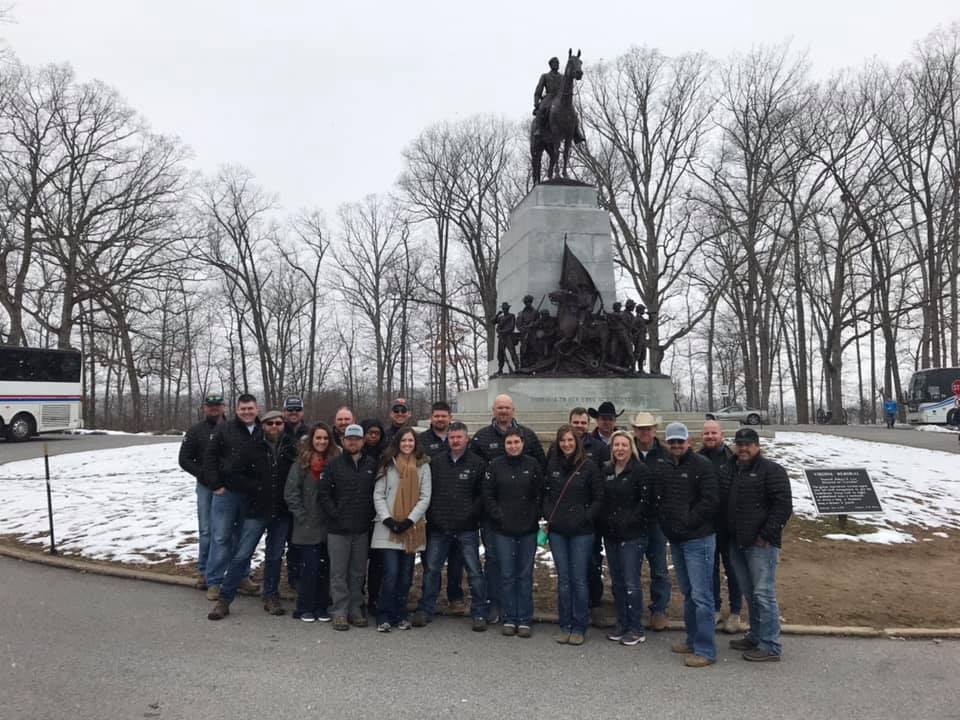
Monday, March 4, 2019
After an evening spent with our host families, the group reunited Monday morning and departed for Milton Hershey School Horticultural Center.
The first presentation at Milton Hershey School was by Rachel Teller, associate director of agriculture and environmental education. Rachel started by giving a history of MHS. Milton and Catherine Hershey started MHS in 1909. The school originally was open to orphaned white males. They were required to work on the dairy as an exchange for housing and received a free education and were prepared to become successful in society. Today, the school is open to any underprivileged child in the nation. MHS has more than 2,000 students ranging from ages 4 to 18. Every MHS graduate receives a full scholarship to the majority of colleges in the U.S. Funding comes directly from the trust established by Milton and Catherine.
Next, Rachel talked about the Agricultural and Environmental Education Program. Agriculture was very important to Milton, and he believed every student should learn about agriculture. The AEE has three sections: Environmental Center, Horticulture Center and Animal Center. The Environmental Center offers several internships and clubs for student to learn more about environmental stewardship. The Horticulture Center is focusing on Hydroponic Green House Systems and the Animal Center focuses on teaching kids traditional animal care and husbandry. The AEE is also focused on teaching STEAM curriculum.
The next speaker was Jean-Philippe Ake. Jean is the senior director of Global Commodities for Hershey Foods Co. Jean spoke to us about the process of purchasing all the commodities that go into Hershey chocolate. His presentation was focused on purchasing sustainable cocoa and purchasing it from countries that support child labor laws. We wrapped up our tour of MHS with a tour of the horticulture greenhouse and animal center.
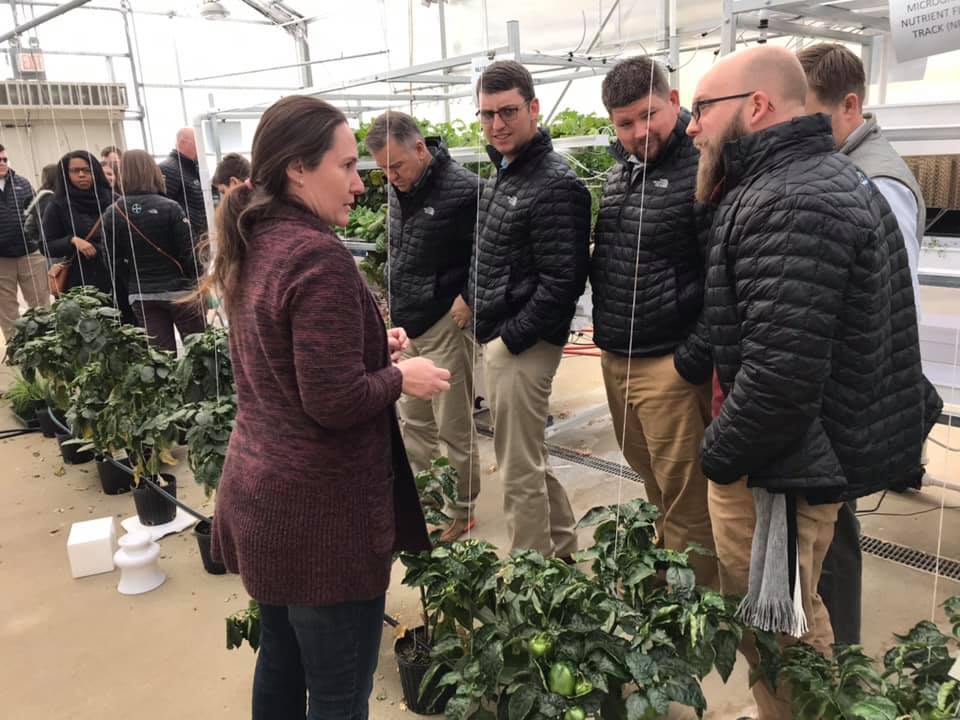
The next stop was much anticipated: Hershey Chocolate World! We spent roughly 30 minutes learning how chocolate is produced and going through the gift shop. We ended the day by touring an Amish farm, hosted by Elam and Sadie King. This was an unique and fun experience. It was interesting to see how a traditional Amish farm operates.
After visiting with the Kings, it was time to head to Washington, D.C. We loaded the bus and everything was going fine until we reached the end of the drive. The bus became stuck in the ice and snow. A pair of nice neighbors stopped to help pull the bus free. Just as they were pulling the bus out, BAM! The front bumper ripped off. Eventually, the bus was pulled out of the rut. Since the front bumper ripped off, we had to drive to the closet strip mall to wait for a new bus. Our class got a good three hours of bonding and quality time together.

After our bus mishap, we were anxious to get to our next destination: Washington, D.C.!
Sincerely,
Kristin Young, Class XIX